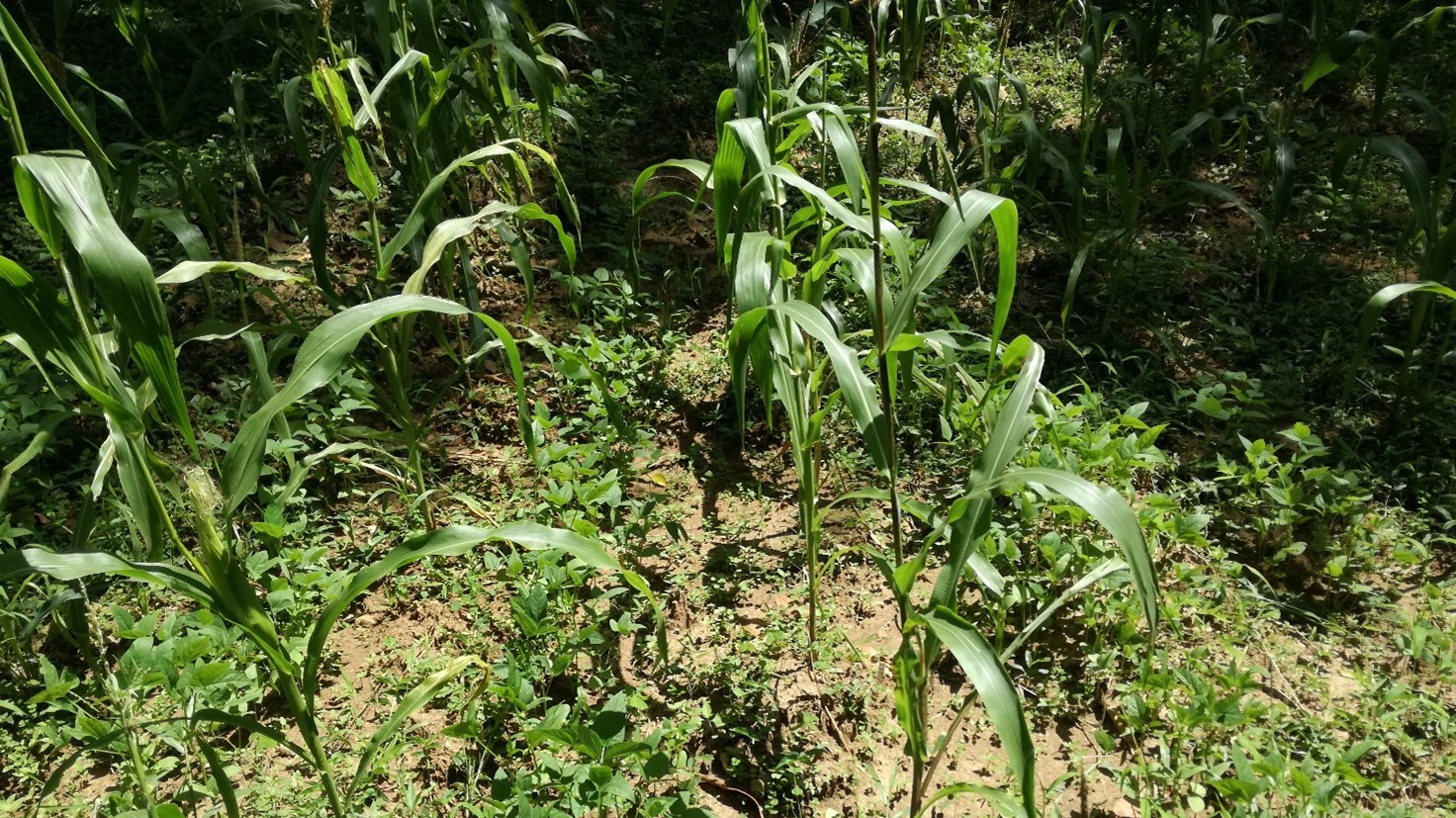Intercropping for better soil and water management

This post is also available in:
This post is also available in:
![]() Español (Spanish)
Español (Spanish) ![]() Français (French)
Français (French) ![]() Deutsch (German)
Deutsch (German) ![]() हिन्दी (Hindi)
हिन्दी (Hindi) ![]() العربية (Arabic)
العربية (Arabic) ![]() Türkçe (Turkish)
Türkçe (Turkish) ![]() 简体中文 (Chinese (Simplified))
简体中文 (Chinese (Simplified)) ![]() Português (Portuguese (Brazil))
Português (Portuguese (Brazil))
Intercropping means growing different crops at the same (or overlapping) time and same area.
Relay intercropping means that crops only overlap some part of the time.
Strip intercropping means stripes of two or more rows of one species are among stripes or a row of other species. (Cover Figure)
Soil-protecting crops can be cultivated among other crops
- Early soil cover. E.g., beans or lettuce may quickly cover the soil in lines or stripes across the slope, while maize, sorghum, millet, or sugar cane take a long time to cover the soil and protect the soil sources. To give the beans more sunlight, e.g., double rows of beans may be used.
- Late cover. Some intercrops may cover and use the soil after others are harvested, e.g., due to slow maturation, being perennial, or by crawling or climbing and flowering profusely as long as the growing season last (some bean cultivars/varieties and cucurbits like melons).
- Low soil cover. Likewise, low crops can protect the soil surface against the big, heavy, fast drops that join at the leaves of taller plants and are not slowed by air friction.
- Crop establishment. Furthermore, crops established in a way that protects soils (e.g., on tied ridges across the slope) can be intercropped with small-seeded crops needing fine tillage and seedbed.
- Less area is needed. The total harvested crop and soil conserving biomass can be increased in the same area, reducing the need to cultivate on slopes and other fragile soils or pastures and forests.
- Make sure at least one crop protects the soil. If one intercrop fails, the others may take much of its place, at least in contour lines. The risk of failure can also be reduced for each crop because the mix is better at:
- protection against strong wind, erosion, and floods;
- providing feed and shelter for natural enemies of crop pests and forming barriers against the spread of some pests and diseases,
- making crops harder to be identified from flying crop pests. Birds and rats can smell and pick up germinating seeds in uniform rows, so a diverse and irregular mixture may help.
Crop rotation
However, intercropping reduces possibilities for complete crop rotation, but, e.g., double rows or stripes can be rotated. Intercropped species may partly differ in their light, water, and nutrient use efficiency. However, even nitrogen-fixing plants mainly fix the amount of nitrogen they need for themselves, most of which is removed with a good seed harvest or even by harvesting tops and roots. Knowledge and management are needed to avoid much damage from some crops to others, e.g., beans climbing on the crop stems.
Maize-bean/cowpea cultivation.
Early soil cover remains the key conservation challenge. Usually, cowpeas of an indeterminate and crawling type that can use the last unreliable rains are seeded at least 2 weeks after maize. The author developed and tested a promising and unconventional intercropping solution for this in southern Ghana in 1986. Fast maturing (60 days) erect high-yielding cowpeas (Vigna unguiculata) were seeded 2 weeks before double rows of dwarf maize across the slope in double rows very early in the rainy season. The cowpeas rapidly protected the soil and flowered before being shaded by the maize plants. Maize requires more consistent rainfalls for seeding. Traditionally, cowpeas continue growing on soil even after harvesting maize. Strip-intercropping can be combined with crop rotation too.
Agroforestry
Agroforestry can also be seen as a type of intercropping – read more information in the next article.
References
- Baumhardt RL, and Blanco-Canqui H 2014 Soil: Conservation Practices. In: Neal Van Alfen, editor-in-chief. Encyclopedia of Agriculture and Food Systems 5, Elsevier, 153-165.
- Hudson W N 1987 Soil and water conservation in semi-arid areas. Silsoe Associates Ampthill, Bedford United Kingdom. Soil Resources, Management and Conservation Service. FAO Land and Water Development Division. Food and Agriculture Organization of the United Nations Rome, 1987 https://www.fao.org/3/t0321e/t0321e00.htm
- Land and Water Division 2000 Manual on Integrated Soil Management and Conservation Practices. FAO land and water bulletin Series number: 1024-6703. 214 pp. ISBN: 9251044171 https://www.fao.org/publications/card/en/c/31f117c4-13e2-5631-bf16-ebaaa10b714f
- Muriuki JP, Macharia PN 2011 Green Water Credits Report K12: Inventory and Analysis of Existing Soil and Water Conservation Practices in Upper Tana, Kenya. https://www.isric.org/documents/document-type/green-water-credits-report-k12-inventory-and-analysis-existing-soil-and Open access.
- Mandal T. 2010. Low-cost soil and water conservation with many early benefits. Presentation Researchers’ Day: Climate Change Impact, Adaptation and Mitigation GEUS, Inst. of Geography, University of Copenhagen. 7 October 2010. Arranged by the Climate Change Task Force. https://www.yumpu.com/en/document/view/35209735/present-danish-water-forum
- Thomas DB et al. 1997. Soil and water conservation manual. Soil and Water Conservation Branch, Min. Agric. Livestock Dev. and Marketing, Nairobi Kenya.
- Watene G and others 2021 Water Erosion Risk Assessment in the Kenya Great Rift Valley Region Sustainability 2021, 13(2), 844; https://doi.org/10.3390/su13020844








































































